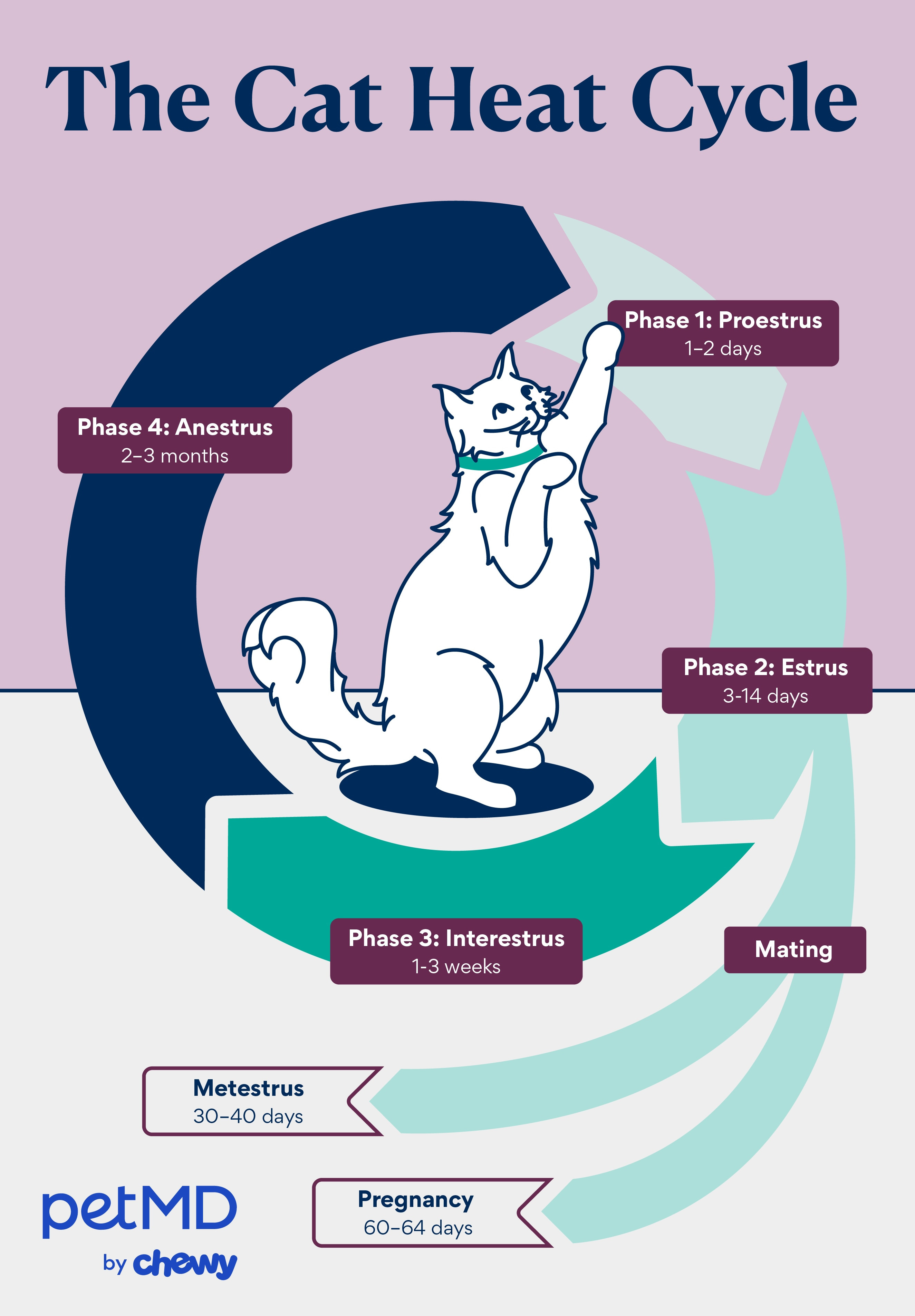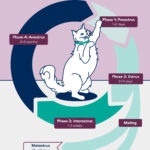If you’re a cat owner who hasn’t spayed their feline friend, understanding the heat cycle is crucial. Unlike dogs or humans, a cat’s estrous cycle presents unique signs. Recognizing these signs is essential for responsible pet ownership and ensuring your queen’s well-being. This guide will walk you through everything you need to know about a cat in heat, from the age of onset to the tell-tale behavioral changes.
When Do Cats Start Going Into Heat?
The age when a cat experiences her first heat cycle can vary, but generally, most queens start cycling between 5 to 9 months old. However, some kittens may start as early as 3-4 months, while others might not until they are around 18 months old. Several factors influence this timing, including your cat’s breed, weight, and even the time of year.
Decoding the Cat Heat Cycle: Stages and Duration
The feline estrous cycle is not a single event but a series of stages, each with distinct characteristics and durations. Understanding these stages can help you better interpret your cat’s behavior.
 illustration depicting a cat
illustration depicting a cat
Proestrus: The Prelude to Heat
Proestrus is the initial stage where estrogen levels begin to rise in your cat’s body. This phase typically lasts for a short period, around one to two days. Interestingly, there are usually no visible symptoms of proestrus that owners can detect. Male cats might show increased interest in a female during this time, but the queen will not be receptive to mating.
Estrus: The Obvious “In Heat” Phase
Estrus is the most noticeable and recognizable stage of the heat cycle, often lasting about a week, but it can range from 3 to 14 days. This is what most people refer to when they say a cat is “in heat.”
During estrus, your female cat will exhibit several significant behavioral changes. She may become excessively affectionate, seeking more attention and physical contact than usual. Vocalization is another key sign – expect increased meowing, caterwauling, or other loud calls as she attempts to attract male cats. Restlessness is also common; she might pace, roll around, or try to escape outdoors. Crucially, estrus is the stage when mating occurs.
Interestrus or Metestrus: Intervals Between Heat Cycles
After estrus, there are two possible phases depending on whether ovulation occurred. Cats are induced ovulators, meaning they only release eggs after mating.
- Metestrus: If your cat mates during estrus and ovulates but the eggs are not fertilized, she enters metestrus. This stage lasts for 30–40 days. If fertilization occurs, it leads to pregnancy, which lasts approximately 60–64 days.
- Interestrus: If your cat does not mate or ovulate during estrus, she will enter interestrus. This is a period of one to three weeks where in-heat behaviors subside before the cycle restarts with proestrus.
Anestrus: The Inactive Period
Cats are seasonal breeders, meaning their heat cycles are influenced by the seasons and daylight hours. Anestrus is the period between active cycles, usually lasting two to three months, where there is minimal hormonal activity. This typically occurs during the shorter daylight months of the year.
How Frequently Do Cats Go Into Heat?
The frequency of cat heat cycles is largely determined by seasonal changes and daylight duration. Cats are considered “long-day breeders” because their cycles become more frequent as daylight hours increase. Spring, especially from February to April, is the peak season for heat cycles. Cycles can continue through October or November before anestrus begins, unless interrupted by pregnancy.
Recognizing the Tell-Tale Signs: Is Your Cat in Heat?
Unlike dogs and humans, cats do not bleed during their heat cycle. The signs of a cat in heat are primarily behavioral. If you’re wondering “How Do You Know If Your Cat Is In Heat?”, look out for these common symptoms:
- Increased Affection: Your cat may become unusually clingy and affectionate, rubbing against furniture, legs, and demanding attention.
- Excessive Vocalization: Expect increased meowing, caterwauling (a loud, drawn-out cry), and other vocalizations as she tries to attract male cats.
- Changes in Appetite: Some cats may experience a decrease in appetite while in heat.
- Restlessness: Your cat might seem agitated, pacing, unable to settle, or constantly seeking escape routes.
- Urine Marking (Less Common): In some cases, cats in heat may urinate more frequently or outside the litter box. However, this is less common than other behavioral signs.
It’s understandable for pet owners to worry that their cat is in pain due to the intensity of these behavioral changes. If you’re concerned about sudden or severe behavioral shifts, always consult your veterinarian.
Managing a Cat in Heat
If you don’t want kittens, keeping your cat indoors during her heat cycle is essential to prevent unwanted pregnancies. Aside from this, there are generally no other necessary lifestyle changes for a cat in heat.
However, it’s important to monitor the duration and frequency of heat cycles. Be aware of potential complications like pseudopregnancy (false pregnancy) or mucometra (mucus in the uterus). Pyometra (uterine infection) is a serious, life-threatening condition that can occur at any age but is more common in middle-aged queens.
Seek veterinary attention immediately if your cat displays any of these symptoms during or after her heat cycle:
- Lethargy or weakness
- Loss of appetite
- Fever
- Vaginal discharge (especially if it is abnormal or foul-smelling)
- Swollen abdomen
Preventing Heat Cycles in Cats: Spaying is Key
The only definitive way to prevent heat cycles and pregnancy is to spay your cat. Unless you are a responsible breeder, there is no compelling reason to leave your cat intact.
Spaying offers significant health benefits. Unspayed cats are not only challenging to manage due to heat-related behaviors, but they are also at higher risk for pyometra, pseudopregnancy, mammary cancer, and ovarian cancer.
There are no known health advantages to allowing a cat to experience a heat cycle before spaying. Veterinarians generally recommend spaying kittens around 5-6 months of age to prevent the onset of heat cycles altogether.
FAQs About Cats in Heat
Do cats bleed when they are in heat?
No, cats should not bleed during a heat cycle or pregnancy. While a clear vaginal discharge during proestrus is rare but possible, any vaginal bleeding warrants an emergency vet visit.
Can you spay a cat while she is in heat?
Yes, spaying a cat in heat is possible and safe. Waiting for anestrus would unnecessarily prolong the risk and inconvenience of heat cycles.
Do male cats go into heat?
No, male cats do not experience heat cycles. However, intact males are always ready to mate with receptive females.
How long does a cat’s heat cycle last?
The “in heat” or estrus phase typically lasts 3 to 14 days, averaging around a week.
How do I confirm if my cat is in heat?
If you suspect your cat is in heat, consult your veterinarian. They can confirm heat and rule out other potential health issues. Behavioral changes like vocalization, increased affection, and restlessness are strong indicators.
By understanding the intricacies of the feline heat cycle and recognizing the signs, you can provide the best care for your unspayed cat and make informed decisions about her reproductive health.
WRITTEN BY Jamie Lovejoy, DVM Veterinarian
Dr. Jamie Lovejoy graduated from Tufts Cummings School of Veterinary Medicine in 2012 after an undergraduate degree in Marine Biology. …


